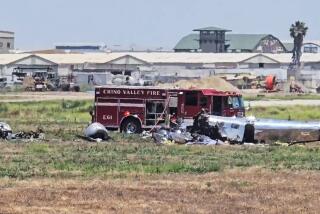China Will Allow U.S. to Examine Spy Plane
- Share via
BEIJING — China will permit U.S. technicians to inspect the damaged Navy spy plane it has held for nearly a month and assess how to return it to the United States, officials in both countries said Sunday.
The official New China News Agency said China had completed its “investigation and evidence collection” of the EP-3 aircraft, which collided in midair with a Chinese fighter jet April 1 and was forced to make an emergency landing on Hainan island in the South China Sea.
U.S. intelligence officials fear that the Chinese recovered classified documents, manuals and other sensitive material from the plane, which was conducting electronic eavesdropping on Chinese military communications facilities when the accident occurred.
U.S. spy satellites have shown busloads of Chinese technicians scouring the $80-million reconnaissance plane, and trucks carting equipment to and from it, since the aircraft landed at a military airfield on Hainan.
“There were lots of people crawling all over that plane,” said a U.S. intelligence official who asked not to be named as a matter of policy. “It would be inconceivable that they wouldn’t try to exploit it.”
The incident, in which the pilot of the Chinese jet was killed and the 24-member U.S. crew was detained for 11 days, dragged relations between Washington and Beijing to their lowest level in two years. Ties were chilled further last week when President Bush announced plans to provide a large package of advanced weapons systems, including submarines, to Taiwan, which China considers part of its territory.
But Beijing’s decision to allow the U.S. aboard the marooned EP-3 was an indication that it wants to move ahead with the bilateral relationship, which involves more than $100 billion in trade.
In its statement Sunday, the Chinese news agency also said: “The U.S. side has agreed to consider making a payment to the Chinese side. The two sides will conduct another round of negotiations on the specific amount of the U.S. payment and the items to be covered.”
But in Washington, both Vice President Dick Cheney and White House Chief of Staff Andrew H. Card Jr. said the U.S. had agreed only to reimburse Beijing for costs associated with removing the damaged plane and will not provide additional compensation.
“We will pay whatever costs are associated with recovering the aircraft in terms of transportation, barge, cranes, whatever is required to get it back out,” Cheney said. “That is legitimately something we ought to pay.”
Appearing on “Fox News Sunday,” Cheney welcomed the Chinese offer to let a U.S. inspection team visit the plane as an “encouraging sign.”
“As we’ve said all along, we do want our aircraft back,” he said. “And the fact that they have now announced that they are willing to have U.S. personnel go in and look at the aircraft, and assess what it is going to take to get it back, I think is very positive.”
U.S. officials said a team of aircraft technicians and intelligence experts was prepared to fly to Hainan as early as today from Kadena Air Base in Okinawa, Japan.
“We expect them to get there as soon as their documentation is ready, their visas are ready,” Card said on ABC-TV’s “This Week.”
The Pentagon has yet to complete an assessment of how much classified material aboard the aircraft was lost to the Chinese or how valuable it could prove to them. But officials acknowledge that the crew was unable to destroy all of the sensitive material on board before it was taken into custody by the Chinese military.
“We think they wiped out electronic data, smashed electronic equipment and destroyed software,” the intelligence official said. “Any documents, manuals, stuff like that, there wasn’t a whole lot of time to get rid of that. There could be some loss there.”
The destruction “wasn’t perfect,” Rear Adm. Craig Quigley, the Pentagon’s chief spokesman, said last week. “But we feel they did the best job that they could.”
The plane, meanwhile, is unable to fly. Its nose cone, which holds navigation equipment, was sheared off in the accident, two of its four propellers were mangled and parts of the fuselage were shredded by metal fragments.
U.S. and Chinese officials still disagree about the cause of the collision. The Pentagon maintains that the Chinese F-8 fighter jet flew too close to the larger, slower spy plane and crashed into it.
China insists that the U.S. plane swerved into its craft. The Chinese pilot, Wang Wei, apparently bailed out but was lost at sea. He now is hailed as a martyr and national hero.
Before the U.S. crew members opened the plane’s door to Chinese troops, they used hammers and axes to disable or destroy intelligence-gathering equipment, including cryptography gear used for secret communications.
The crew was released after the Bush administration said it was “very sorry” for the loss of the Chinese pilot and for the U.S. plane’s unauthorized entry into Chinese airspace to make the emergency landing.
After the crew’s release, the two governments met April 18-19 in Beijing. U.S. negotiators presented a written proposal for U.S. technicians to inspect the plane to determine whether it could be repaired and flown out or would have to be shipped out in pieces.
The Pentagon has suspended its intelligence-gathering flights in international airspace off the Chinese coast since the incident, but the Bush administration says it does not intend to heed China’s demands that it end the flights for good.
*
Chu reported from Beijing and Drogin from Washington.
More to Read
Sign up for Essential California
The most important California stories and recommendations in your inbox every morning.
You may occasionally receive promotional content from the Los Angeles Times.















